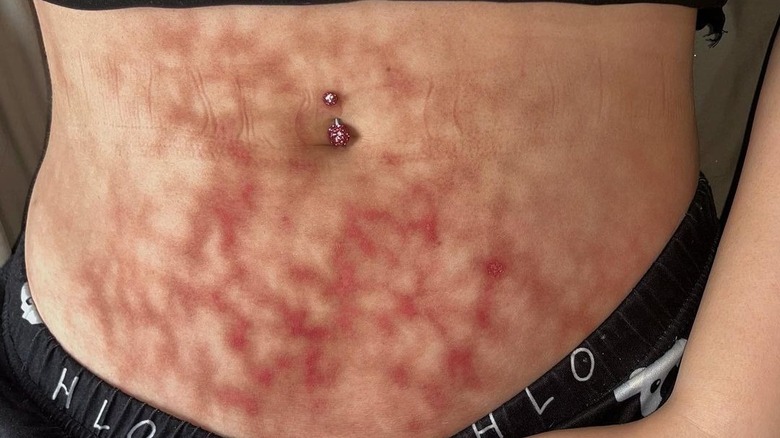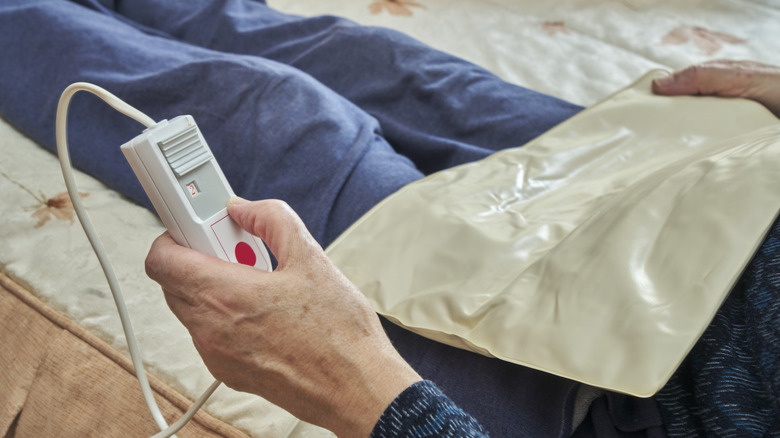Toasted Skin Syndrome: What To Know & How To Avoid It
Some days, work-from-home life can look like cozying up on the couch with your laptop on your lap. While it might be more comfortable than sitting at your desk, the heat from your laptop might actually be causing a skin condition known as "toasted skin syndrome," scientifically known as erythema ab igne. The condition shows up as a flat, blotchy red or brown rash that can sometimes feel itchy as a result of repeated exposure to low-grade heat.
Laptop heat is just one common culprit of toasted skin syndrome, but there are many others, including heating pads, hot water bottles, space heaters, and heated car seats. Research published in the Cureus medical journal states that the rash is benign and can resolve itself within weeks or months, but rare cases have occurred where the rash progressed into more serious conditions like skin cancer. But don't let that worry you too much – toasted skin syndrome can be easily prevented and treated.
How does toasted skin syndrome occur?
Toasted skin syndrome is caused by frequent exposure to low-grade heat, ranging from 43-47°Celcius, or about 109-116° Fahrenheit. As described in a report from the Dermatology Online Journal, when the skin is exposed to this level of heat for multiple hours over several days, blood vessels close to the surface become damaged and create a "net-like pigmentation."
The condition has been historically seen among bakers and industrial workers who frequently work near heat, but over the past few years, it's been popping up among remote workers who use a laptop. It can also be caused by using heating pads to relieve pain during your period or lower back pain. Even using space heaters and heated car seats for too long can also bring on toasted skin syndrome. A 2020 report found that 90% of laptop-induced toasted skin syndrome is found on the legs and thighs.
Although the condition is mostly a cosmetic issue, it's never good to repeatedly expose your skin to too much heat. Over time, the rash can darken and physical symptoms can worsen from a mere itch to blisters and pain. Some experts warn that in extreme cases of toasted skin syndrome gone untreated, the pigmentation may become permanent and progress to types of skin cancers like Merkel cell carcinoma, basal cell carcinoma, and squamous cell carcinoma. However, it's worth noting this is incredibly rare.
Preventing and treating toasted skin syndrome
Toasted skin syndrome generally resolves on its own once you remove the heat source, but the best way to avoid it is prevention. Be mindful when you're around a heat source to ensure your bare skin isn't being directly exposed. If you like working with a laptop on your lap, place it on a pillow or stand to protect your legs from the heat. Avoid placing heat pads directly on the skin, and try not to use them for too long. You can try using them on and off in short intervals to give your skin a break while still managing your pain.
If you notice signs of toasted skin syndrome, there are topical solutions to help reverse the damage and lessen the appearance of it, but you'll want to act quickly. Dermatologist Lavanya Krishnan, MD, FAAD tells Byrdie, "Depending on the location of the rash, areas with thinner skin may respond to over-the-counter Hydrocortisone 1-2% cream (a topical steroid cream). Over-the-counter retinol creams, like Differin 0.1% gel can also be helpful." However, if toasted skin syndrome has already caused severe skin darkening, you may need more invasive laser treatment. It's best to speak to a medical professional about any concerns you have relating to your skin.


